Abstract
A simple and compact system suitable for the preservation of fragile gram negative anaerobes and other bacteria in liquid N2 has been developed. Polypropylene straws used as specimen containers can be used easily within glove bags of anaerobic chambers, and their small size greatly increases the number of cultures which can be stored. Ancillary equipment and methods developed are described. The overall system was tested, using Streptococcus mutans, Fusobacterium nucleatum, and Selenomonas sputigena. Various basal suspending fluids and cryoprotective supplements were studied. With fast rates of freezing and thawing, survival recoveries of the test microorganisms ranged from 80 to 100 percent of the input colony-forming units in a complex medium broth base without cryoprotective agent addition, and they consistently were 100 percent when 0.4 mM polyvinylpyrrolidine was used. Overall, cryoprotection by polyvinyl pyrrolidine was superior to that from glycerol or dimethyl sulfoxide, the latter yielding recoveries similar to or less than those obtained with no cryoprotectant additive. All microorganisms were recoverable after storage for 1 year.
Full text
PDF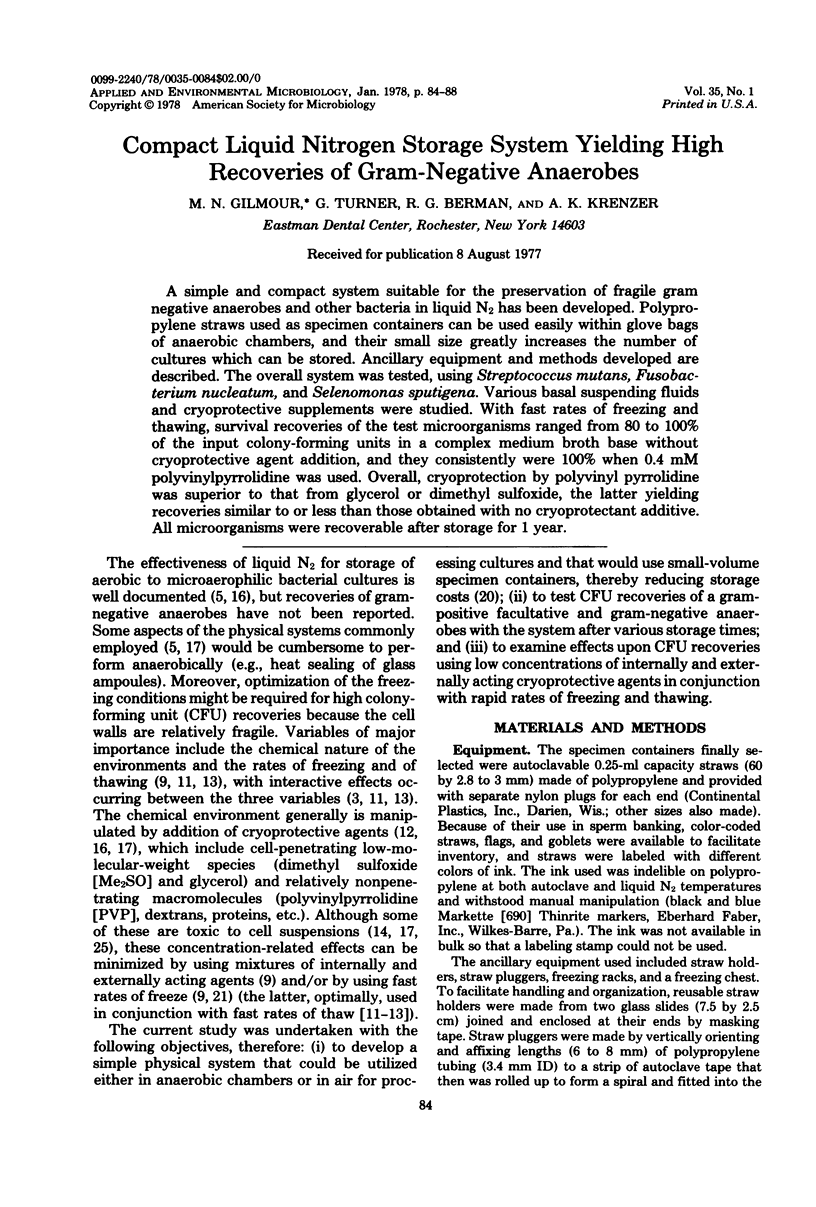
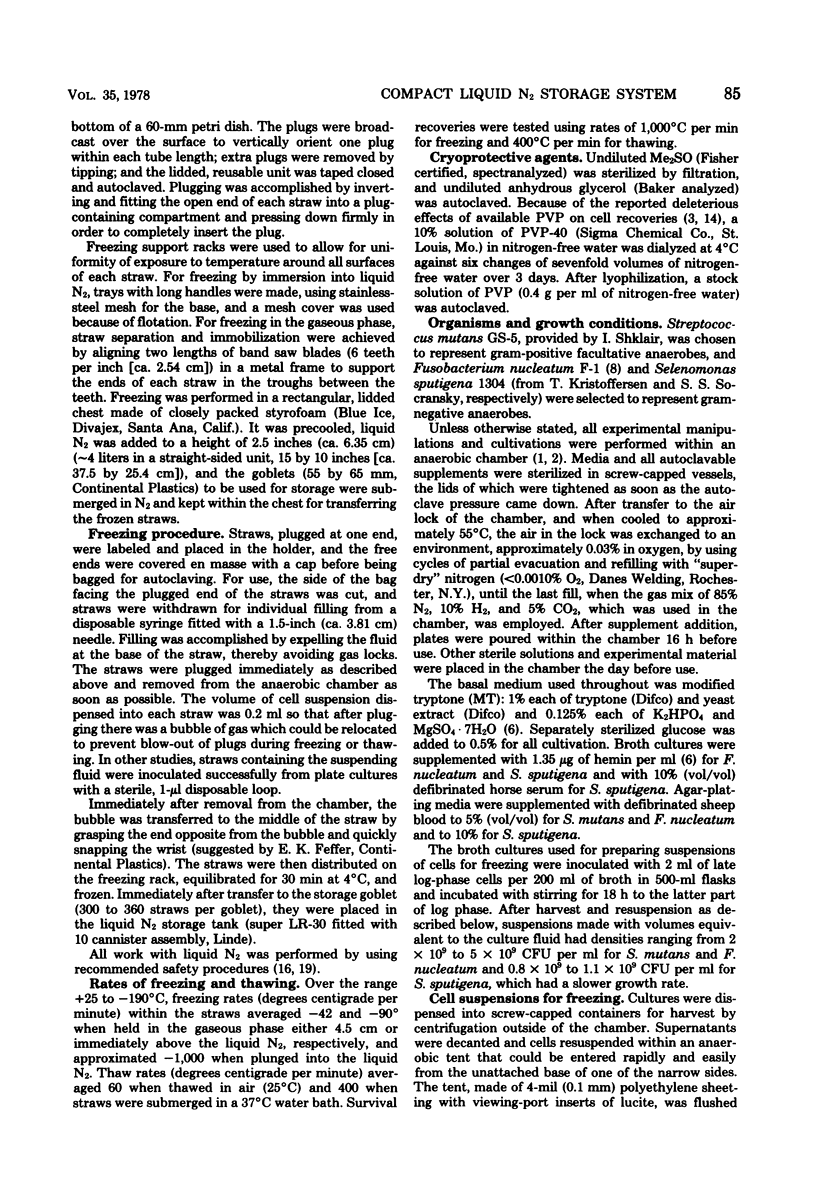
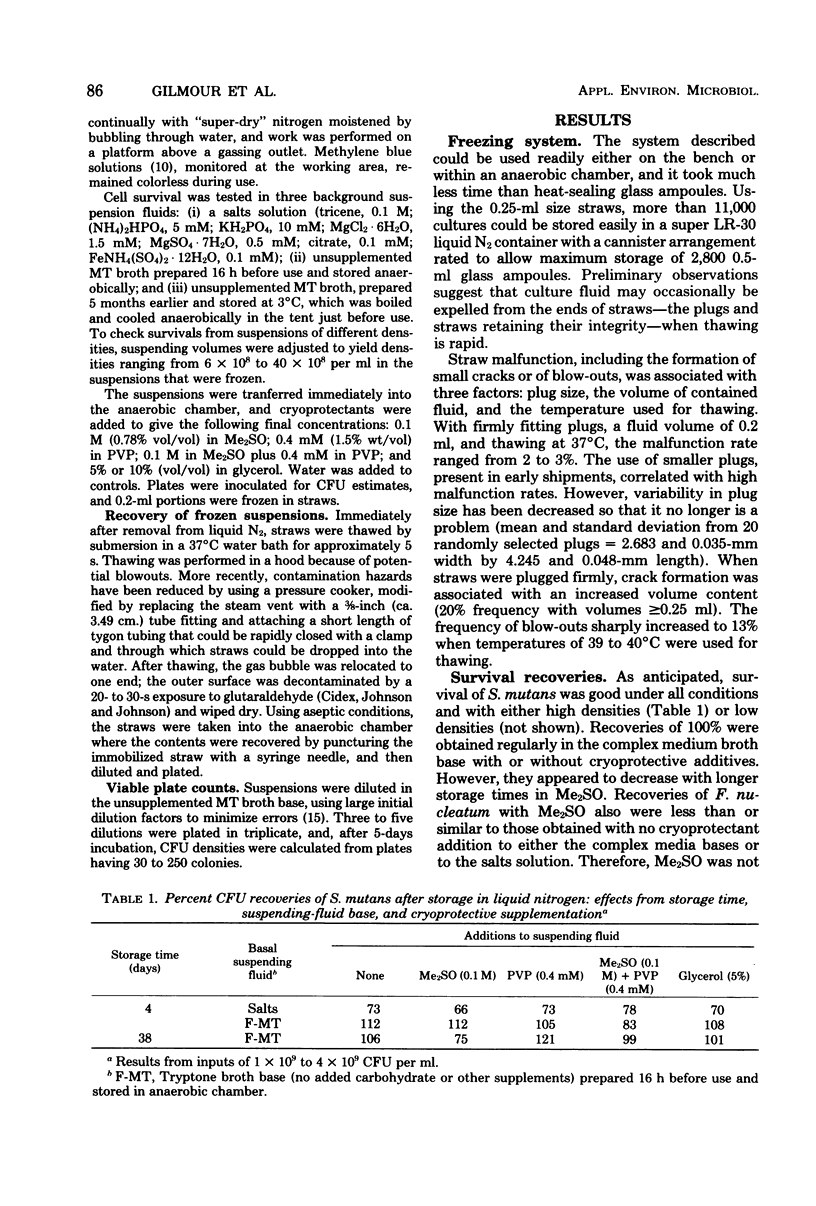
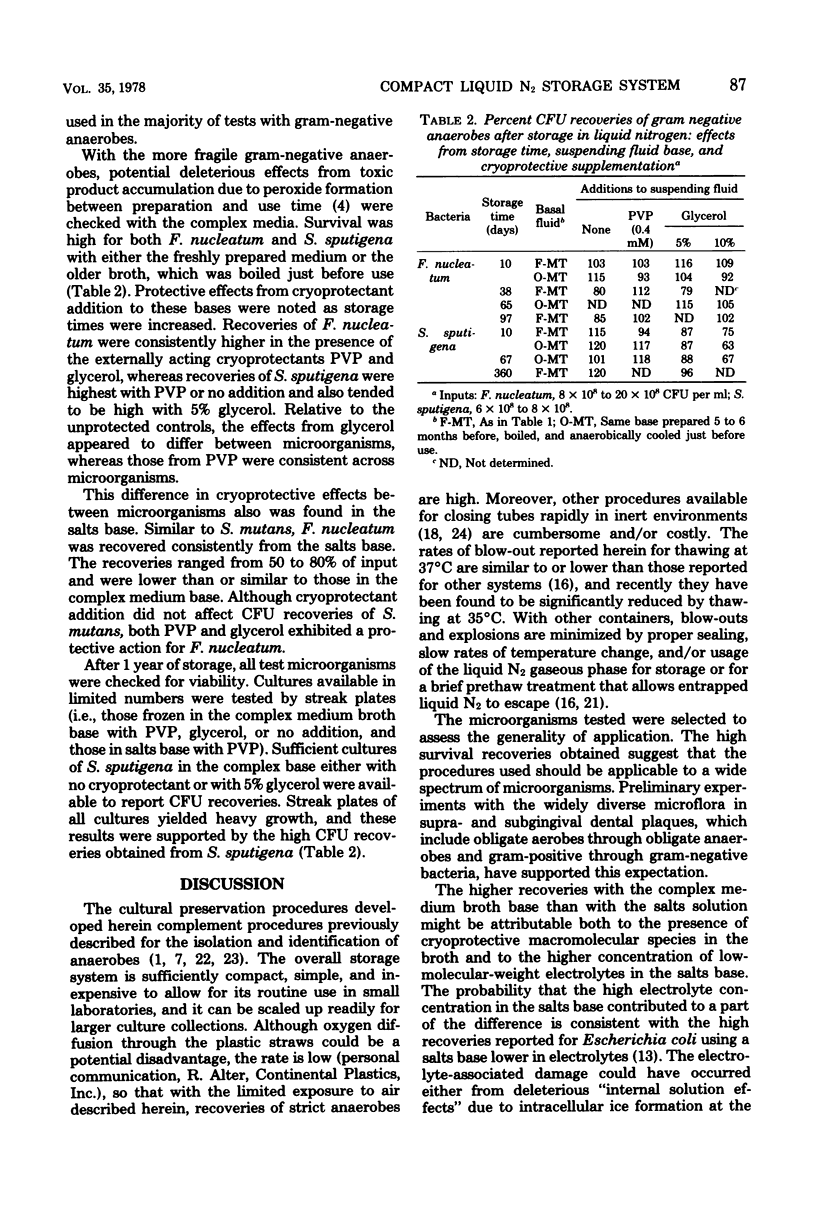
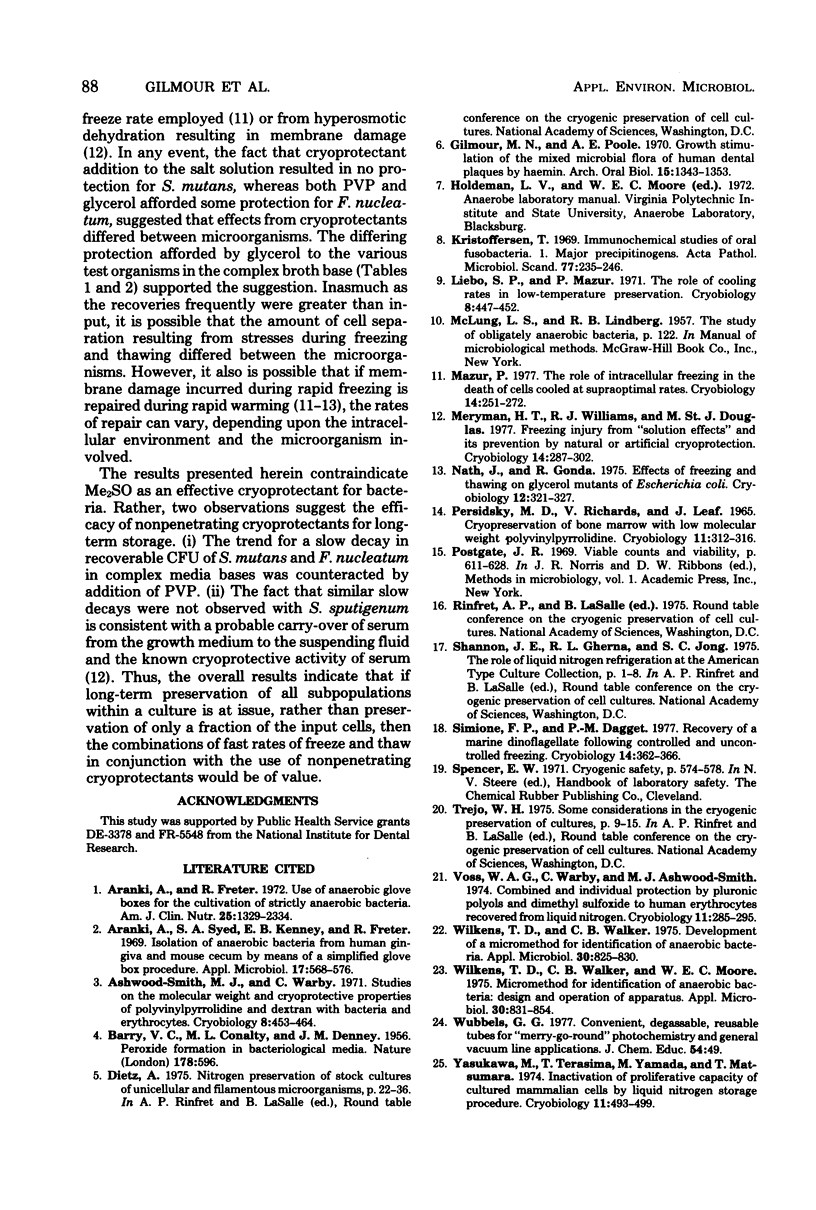
Selected References
These references are in PubMed. This may not be the complete list of references from this article.
- Arank A., Syed S. A., Kenney E. B., Freter R. Isolation of anaerobic bacteria from human gingiva and mouse cecum by means of a simplified glove box procedure. Appl Microbiol. 1969 Apr;17(4):568–576. doi: 10.1128/am.17.4.568-576.1969. [DOI] [PMC free article] [PubMed] [Google Scholar]
- Aranki A., Freter R. Use of anaerobic glove boxes for the cultivation of strictly anaerobic bacteria. Am J Clin Nutr. 1972 Dec;25(12):1329–1334. doi: 10.1093/ajcn/25.12.1329. [DOI] [PubMed] [Google Scholar]
- Ashwood-Smith M. J., Warby C. Studies on the molecular weight and cryoprotective properties of polyvinylpyrrolidone and dextran with bacteria and erythrocytes. Cryobiology. 1971 Oct;8(5):453–464. doi: 10.1016/0011-2240(71)90036-8. [DOI] [PubMed] [Google Scholar]
- BARRY V. C., CONALTY M. L., DENNENY J. M., WINDER F. Peroxide formation in bacteriological media. Nature. 1956 Sep 15;178(4533):596–597. doi: 10.1038/178596a0. [DOI] [PubMed] [Google Scholar]
- Gilmour M. N., Poole A. E. Growth stimulation of the mixed microbial flora of human dental plaques by haemin. Arch Oral Biol. 1970 Dec;15(12):1343–1353. doi: 10.1016/0003-9969(70)90022-1. [DOI] [PubMed] [Google Scholar]
- Kristoffersen T. Immunochemical studies of oral Fusobacteria. 1. Major precipitinogens. Acta Pathol Microbiol Scand. 1969;77(2):235–246. doi: 10.1111/j.1699-0463.1969.tb04228.x. [DOI] [PubMed] [Google Scholar]
- Leibo S. P., Mazur P. The role of cooling rates in low-temperature preservation. Cryobiology. 1971 Oct;8(5):447–452. doi: 10.1016/0011-2240(71)90035-6. [DOI] [PubMed] [Google Scholar]
- Mazur P. The role of intracellular freezing in the death of cells cooled at supraoptimal rates. Cryobiology. 1977 Jun;14(3):251–272. doi: 10.1016/0011-2240(77)90175-4. [DOI] [PubMed] [Google Scholar]
- Meryman H. T., Williams R. J., Douglas M. S. Freezing injury from "solution effects" and its prevention by natural or artificial cryoprotection. Cryobiology. 1977 Jun;14(3):287–302. doi: 10.1016/0011-2240(77)90177-8. [DOI] [PubMed] [Google Scholar]
- Nath J., Gonda S. R. Effects of freezing and thawing on glycerol mutants of Escherichia coli. Cryobiology. 1975 Aug;12(4):321–327. doi: 10.1016/0011-2240(75)90005-x. [DOI] [PubMed] [Google Scholar]
- Simione F. P., Jr, Daggett P. M. Recovery of a marine dinoflagellate following controlled and uncontrolled freezing. Cryobiology. 1977 Jun;14(3):362–366. doi: 10.1016/0011-2240(77)90183-3. [DOI] [PubMed] [Google Scholar]
- Voss W. A., Ashwood-Smith M. J., Warby C. Combined and individual protection by pluronic polyols and dimethyl sulfoxide to human erythrocytes recovered from liquid nitrogen. Cryobiology. 1974 Aug;11(4):285–295. doi: 10.1016/0011-2240(74)90004-2. [DOI] [PubMed] [Google Scholar]
- Wilkins T. D., Walker C. B. Development of a micromethod for identification of anaerobic bacteria. Appl Microbiol. 1975 Nov;30(5):825–830. doi: 10.1128/am.30.5.825-830.1975. [DOI] [PMC free article] [PubMed] [Google Scholar]
- Wilkins T. D., Walker C. B., Moore W. E. Micromethod for identification of anaerobic bacteria: design and operation of apparatus. Appl Microbiol. 1975 Nov;30(5):831–837. doi: 10.1128/am.30.5.831-837.1975. [DOI] [PMC free article] [PubMed] [Google Scholar]
- Yasukawa M., Terasima T., Yamada M., Matsumura T. Inactivation of proliferative capacity of cultured mammalian cells by liquid nitrogen storage procedure. Cryobiology. 1974 Dec;11(6):493–499. doi: 10.1016/0011-2240(74)90118-7. [DOI] [PubMed] [Google Scholar]


